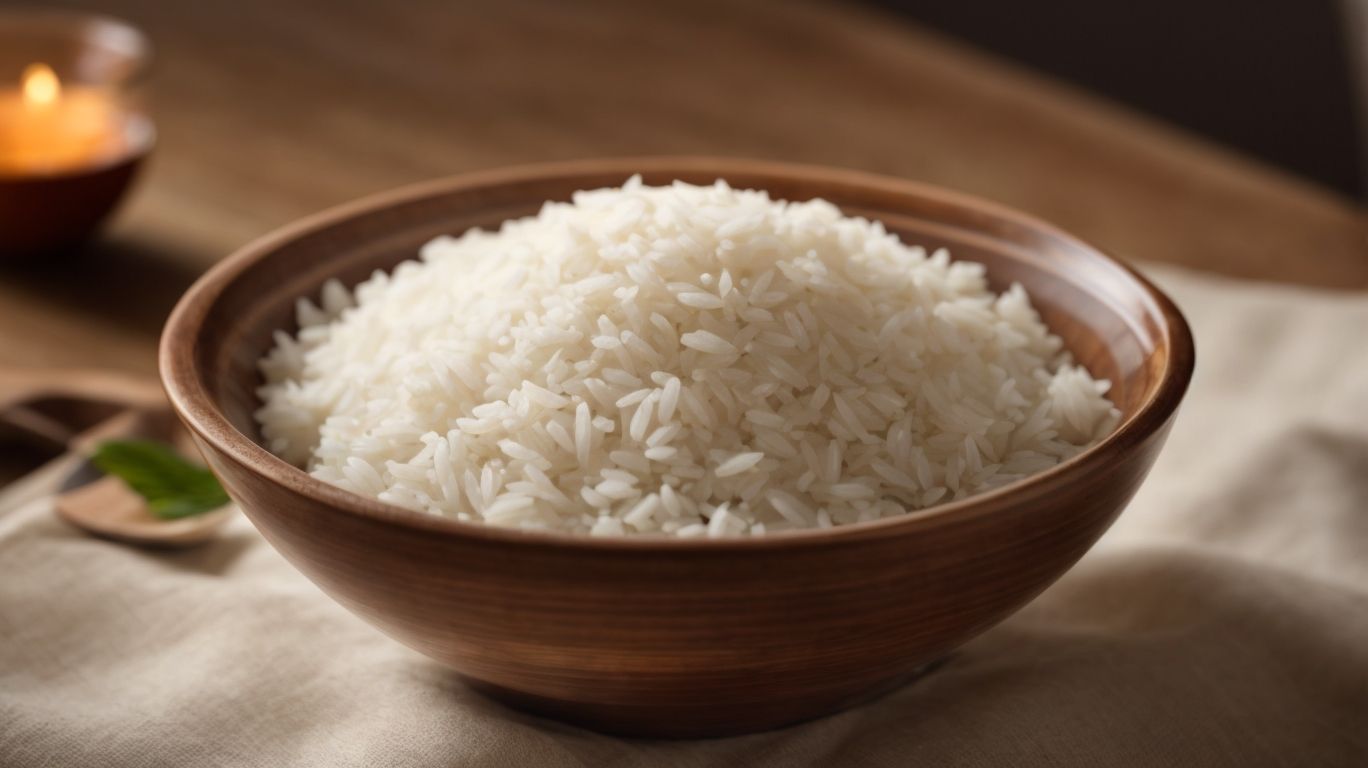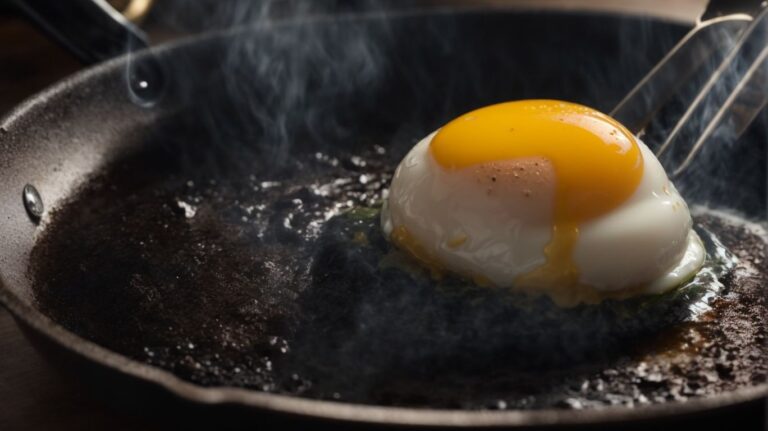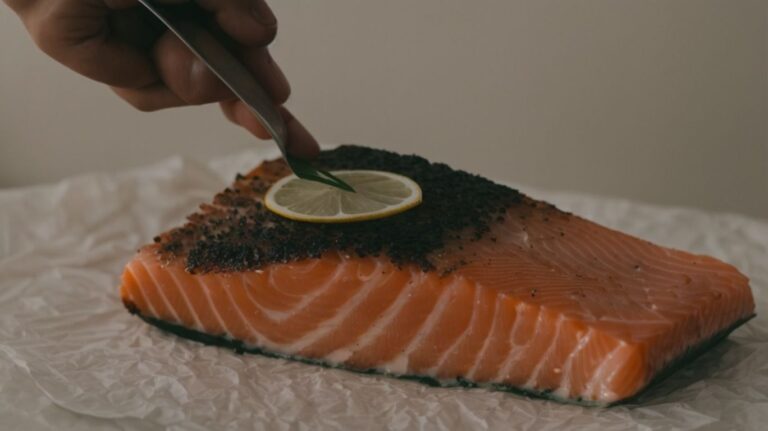How to Cook Rice With Coconut?
Are you looking to elevate your rice dishes to a whole new level of deliciousness? Incorporating coconut into your cooking can be the perfect solution!
We will explore why using coconut in cooking rice is a game-changer, which types of rice work best with coconut, and what equipment you need to get started.
Learn how to prepare the rice and coconut mixture, cook it to perfection, and get some tips for achieving perfectly cooked coconut rice every time.
Discover mouth-watering recipes featuring coconut rice and get ready to impress your family and friends with your new culinary skills!
Key Takeaways:
Why Use Coconut in Cooking Rice?
Coconut adds a unique and delightful flavor profile to rice dishes, especially in Asian cuisine. Incorporating coconut into rice not only enhances the taste but also offers a creamy and fluffy texture that complements a wide range of meal pairings.
By infusing coconut milk or shredded coconut into the cooking process, the rice absorbs this tropical essence, creating a rich and fragrant base that can be paired with various ingredients.
This infusion of coconut not only adds a subtle sweetness but also a hint of nuttiness that elevates the overall dining experience.
Whether used in savory dishes like curries or stir-fries, or in sweet creations like coconut rice pudding or mango sticky rice, coconut rice provides a versatile canvas for culinary experimentation.
What Types of Rice Work Best with Coconut?
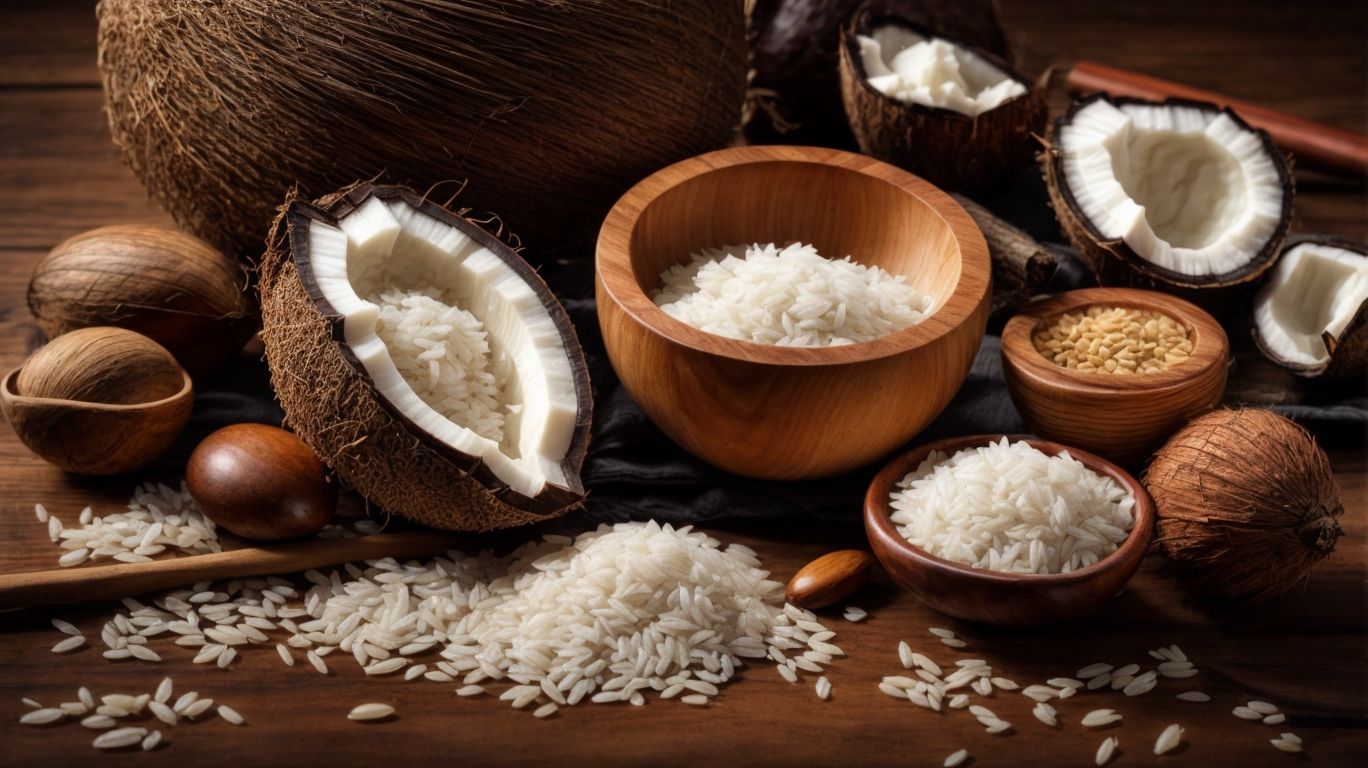
Credits: Poormet.Com – Elijah Smith
When cooking with coconut, certain rice varieties such as jasmine rice and Basmati rice work exceptionally well due to their ability to absorb flavors effectively. These rice types create a perfect base for coconut-infused dishes, enhancing the overall taste experience.
Both jasmine rice and Basmati rice have long grains that stay separate and fluffy when cooked, making them an ideal choice for coconut rice recipes.
- Jasmine rice, known for its fragrant aroma and slightly sticky texture, pairs harmoniously with the sweet notes of coconut, infusing each grain with a delightful essence.
- On the other hand, Basmati rice brings a nuttier flavor and a delicate, fluffy texture that complements the creamy richness of coconut milk, resulting in a luxurious and satisfying dish.
What Equipment Do You Need for Cooking Rice with Coconut?
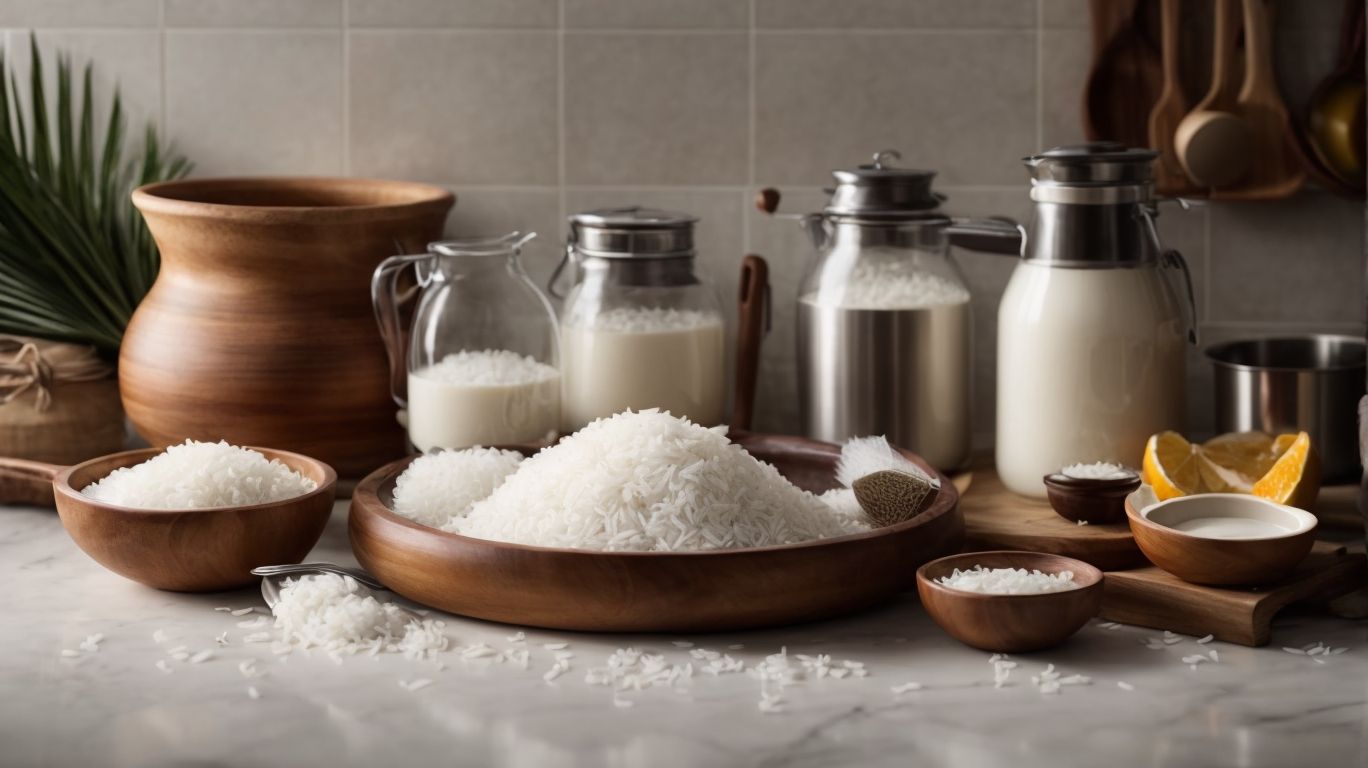
Credits: Poormet.Com – Gregory Brown
To prepare coconut rice, essential equipment includes a rice cooker for convenient cooking, along with basic ingredients like water, sugar, and of course, coconut milk. These tools are fundamental for achieving the desired texture and flavor in your coconut rice recipe.
You will need a sharp knife for opening the coconut and a grater for extracting fresh coconut shreds. A medium-sized saucepan or pot is useful for preparing the coconut milk mixture before adding it to the rice cooker. Don’t forget a measuring cup to ensure accurate ratios of water to coconut milk. For added flavor, ingredients like pandan leaves or lemongrass can elevate the aroma of your coconut rice.
How to Prepare the Rice and Coconut Mixture?
The process of preparing the rice and coconut mixture involves soaking the jasmine rice to enhance its texture and flavor absorption, as well as preparing the creamy coconut milk mixture. These initial steps lay the foundation for a delicious and aromatic coconut rice dish.
Soaking the jasmine rice is a crucial step as it helps the grains to soften and expand, resulting in a fluffy and tender texture when cooked. This process also allows the rice to better absorb the flavors of the coconut milk infusion, creating a rich and fragrant base for the dish.
In terms of preparing the coconut milk infusion, different techniques can be used to achieve varying levels of creaminess and intensity in flavor. Extracting fresh coconut milk from grated coconut yields a more vibrant and authentic taste compared to using canned coconut milk.
Soaking the Rice
Soaking jasmine rice before cooking is a crucial step in the coconut rice preparation process, as it allows the grains to absorb moisture and flavors more effectively.
This simple yet essential technique enhances the overall texture and taste of the final dish. By soaking the jasmine rice, the grains soften and expand, resulting in a fluffy and aromatic coconut rice. The soaking process also helps to reduce the cooking time and ensures that the rice cooks evenly.
For optimal results, it is recommended to soak jasmine rice for at least 30 minutes up to 2 hours in cold water before cooking. This duration allows the grains to fully hydrate and ensures a perfect balance of moisture throughout the rice.
Preparing the Coconut Milk
Creating a rich and creamy coconut milk mixture is a key aspect of preparing coconut rice. This step involves blending coconut milk with other ingredients to achieve a smooth and flavorful base that infuses the rice with a tropical coconut essence.
One technique to enhance the creaminess is to use full-fat coconut milk instead of its lighter versions, as it adds a lush texture and richer taste to the rice. Incorporating a dash of coconut cream can amplify the luxurious mouthfeel of the dish, elevating its overall indulgence. Balancing the sweetness with a hint of coconut sugar or palm sugar can bring out the nuanced flavors and create a harmonious blend of sweet and savory notes.
What are the Steps for Cooking Rice with Coconut?
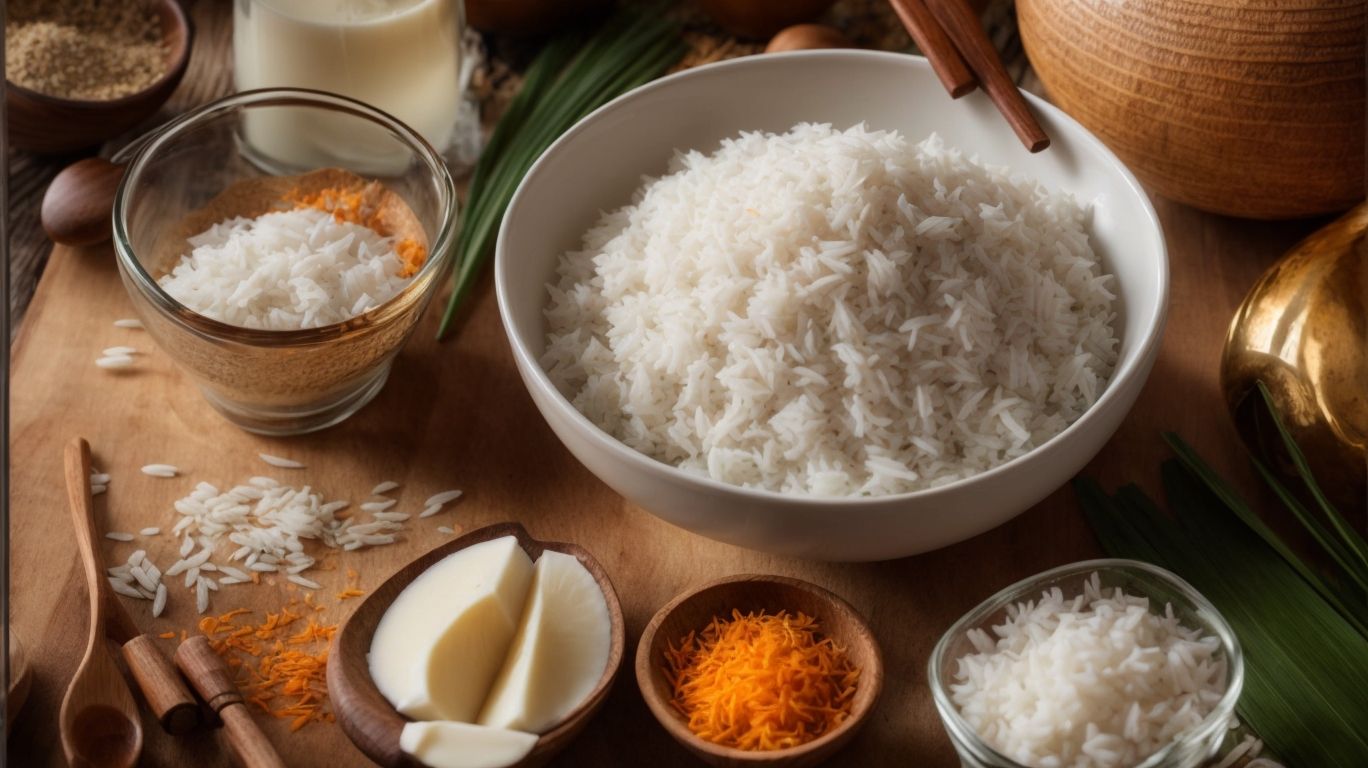
Credits: Poormet.Com – Bryan Harris
Cooking rice with coconut involves a straightforward process that includes simmering the rice and coconut milk mixture until perfectly cooked. The resulting dish boasts a delicious coconut flavor and a fluffy texture that pairs well with a variety of main meals and sides.
Start by rinsing the rice to remove excess starch, which helps achieve a separated, fluffy texture. Then, in a pot, combine the rice, coconut milk, water, and a pinch of salt for seasoning. Bring this mixture to a boil, then reduce the heat and let it simmer gently until all the liquid is absorbed, and the rice is tender.
The key is to stir occasionally to prevent sticking and to ensure even cooking. Once done, let the coconut rice rest covered for a few minutes to allow any excess moisture to evaporate, resulting in a perfect consistency.
Cooking the Rice and Coconut Mixture
Cooking the rice and coconut mixture requires gentle simmering to allow the flavors to meld and the rice to absorb the creamy coconut essence fully. This cooking process results in a fragrant and flavorful dish that embodies the essence of Asian cuisine.
During the simmering process, the rice grains gradually expand and soften, soaking up the rich, coconut-infused liquid. The slow cooking method ensures that every bite bursts with the subtle sweetness and nutty undertones of the coconut. This aromatic quality makes coconut rice a versatile accompaniment, perfect for complementing a wide array of Asian-inspired dishes. Whether paired with spicy curries, succulent stir-fries, or zesty seafood dishes, coconut rice effortlessly enhances the overall flavor profile, creating a harmonious balance of tastes and textures.
Fluffing the Rice
Fluffing the cooked coconut rice with a fork is a simple yet essential step to ensure a light and fluffy texture. This process separates the grains and enhances the presentation of the dish, making it an appealing and delicious side dish.
When you fluff the rice, you are not just mixing it; you are allowing air to circulate between the grains, giving it that signature light and airy feel. The visual appeal is heightened as the individual grains stand out, creating a fluffy mound of rice on your plate. Proper fluffing also impacts the taste by preventing clumping and ensuring each bite is perfectly seasoned.
What are Some Tips for Perfectly Cooked Coconut Rice?
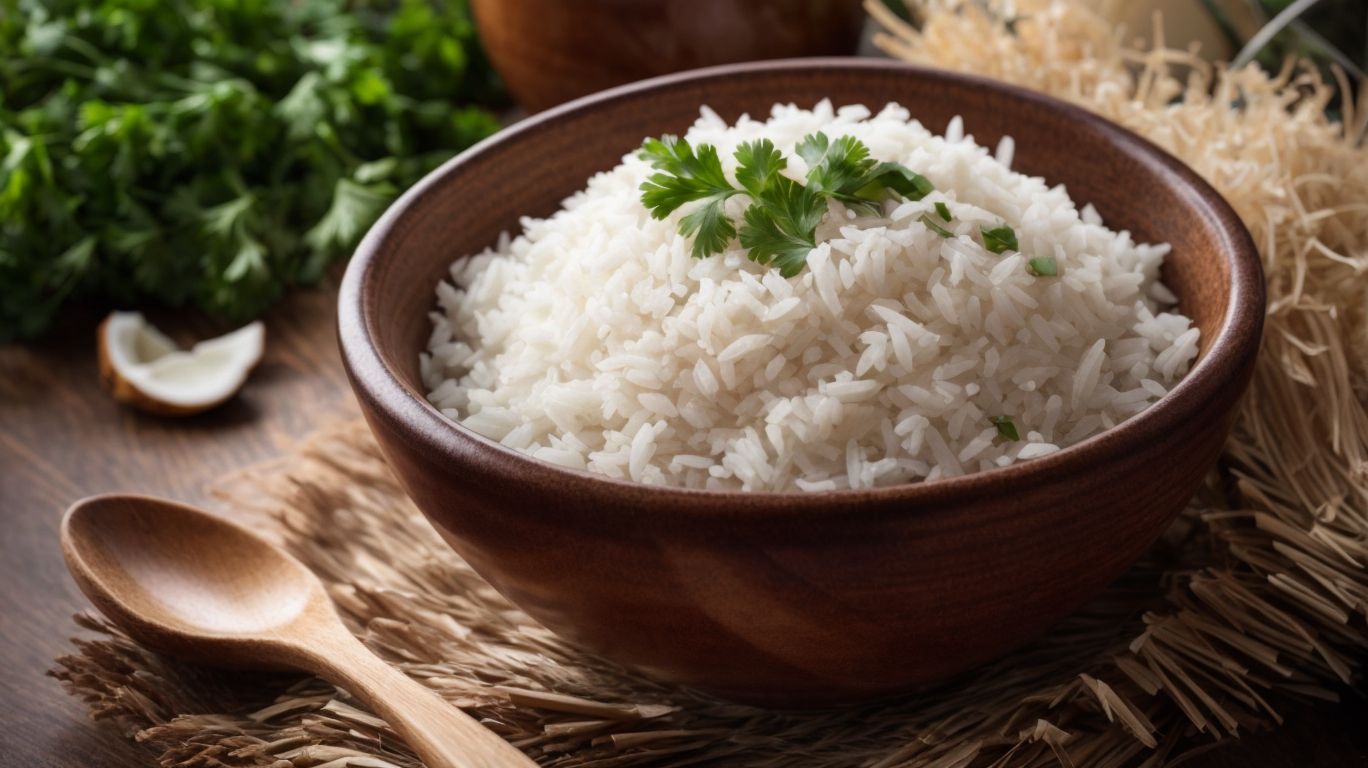
Credits: Poormet.Com – Jacob Hill
For perfectly cooked coconut rice, it is essential to use the right ratio of rice to coconut milk, allow the rice to rest before serving, and add flavorful additions to enhance the taste profile. These tips ensure a delightful and satisfying coconut rice experience.
When cooking coconut rice, the ideal ratio is typically one part rice to one part coconut milk for a rich and creamy texture. Allowing the rice to rest after cooking helps it absorb any excess moisture, resulting in a perfectly fluffy consistency.
To elevate the flavor of your coconut rice, consider incorporating aromatic ingredients such as lemongrass, ginger, or even a hint of chili for a subtle kick. The versatility of coconut rice extends to various cuisines; you can pair it with tropical fruits like mango for a refreshing twist or serve it alongside spicy curries or grilled meats for a savory meal.
Use the Right Ratio of Rice to Coconut Milk
Achieving the perfect balance of rice to coconut milk is crucial for creating a creamy and flavorful coconut rice dish. The right ratio ensures that the rice absorbs the coconut essence while maintaining a desirable texture that is both rich and satisfying.
The rice-to-coconut milk ratio plays a pivotal role in determining the overall taste and mouthfeel of the dish. Too much coconut milk can overpower the dish, making it excessively rich, while too little can result in a dry and bland outcome. By adjusting the ratio, you can customize the level of creaminess, coconut flavor, and consistency based on your preferences. Experimenting with different ratios allows you to fine-tune the dish to suit your taste buds perfectly.
Let the Rice Rest Before Serving
Allowing the cooked coconut rice to rest before serving is essential for the flavors to meld and the texture to settle. This resting period enhances the overall taste experience and ensures that the dish is at its best when presented to diners.
During the resting phase, the rice grains have time to absorb any remaining liquids, resulting in a more consistent and flavorful dish. This also allows the aromas of the coconut to fully permeate the rice, enhancing its tropical essence. It is recommended to let the coconut rice rest for approximately 5 to 10 minutes, covering it with a clean tea towel to retain heat and moisture.
Add Flavorful Additions to the Rice
Enhancing coconut rice with flavorful additions such as tropical fruits, fragrant herbs like cilantro and lime, or savory spices can elevate the dish to new culinary heights. These customizable options allow for creative variations that cater to diverse palates and preferences.
For a burst of sweetness, try incorporating diced mangoes or chunks of pineapple into the coconut rice. The juicy tropical flavors beautifully complement the coconut’s creaminess, adding a delightful twist to each bite.
For those who enjoy a bit of heat, consider adding a touch of chili flakes or minced jalapeños to infuse some spicy notes into the dish. The subtle kick balances well with the coconut’s richness, creating a harmonious balance of flavors.
What are Some Delicious Recipes Using Coconut Rice?
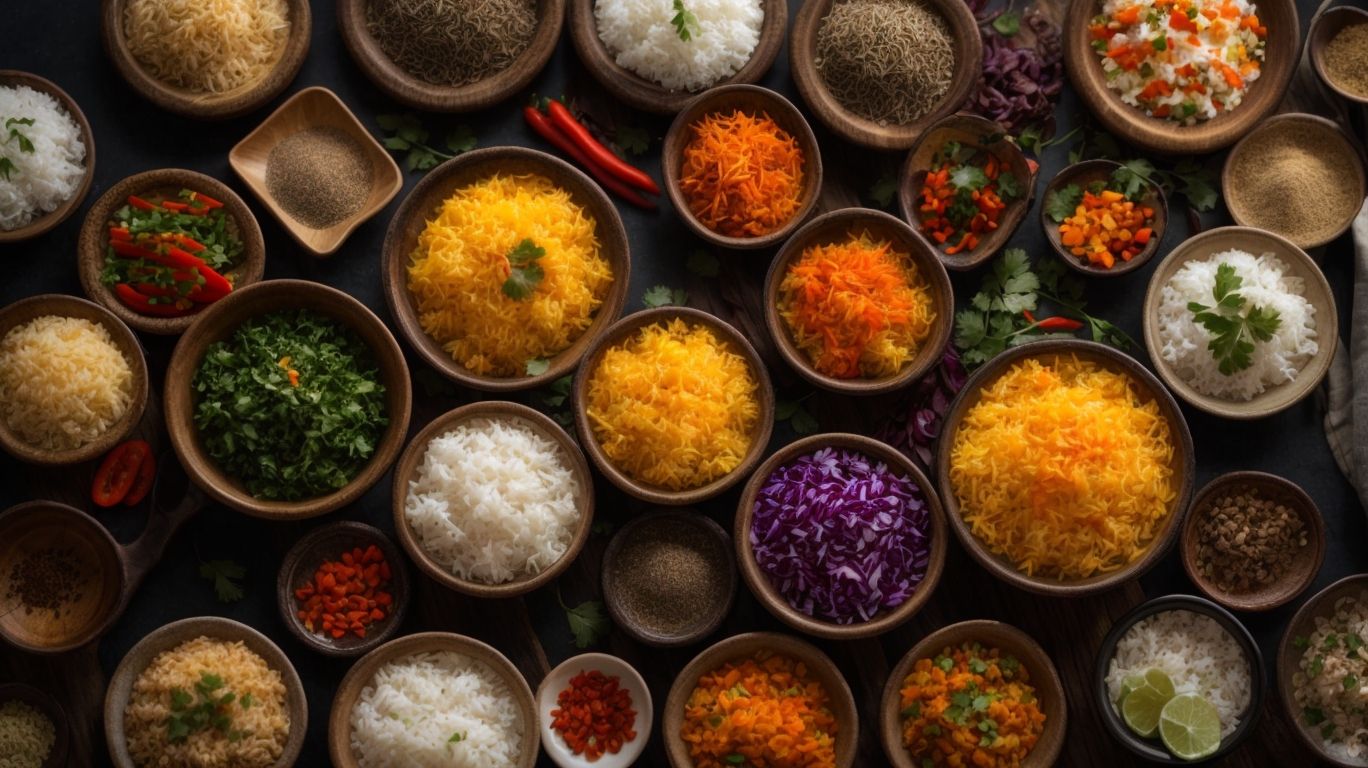
Credits: Poormet.Com – Bryan Mitchell
Dive into a world of culinary delights with delicious recipes that feature coconut rice as the star ingredient. From creamy coconut rice pudding to aromatic coconut fried rice and hearty coconut rice and beans, these dishes showcase the versatility and appeal of coconut-infused creations.
One popular variation is a Thai-inspired coconut rice with a hint of lemongrass and lime zest, offering a refreshing and tangy twist to the traditional dish. For those craving a savory option, a coconut curry rice served with spicy grilled shrimp or tofu is a perfect choice. To satisfy your sweet tooth, consider a tropical coconut and mango rice dessert topped with a dollop of coconut whipped cream and a sprinkle of toasted coconut flakes for added texture.
For a fusion recipe, try a Caribbean-style coconut rice and pigeon peas stew brimming with rich flavors of coconut milk, thyme, and Scotch bonnet pepper. If you prefer a lighter meal, a refreshing coconut lime cilantro rice salad paired with grilled chicken or avocado slices provides a delightful mix of zesty and creamy flavors.
Coconut Rice Pudding
Indulge in the decadent delight of coconut rice pudding, a luscious dessert that combines the creamy texture of coconut-infused rice with tropical sweetness. This comforting treat is a perfect fusion of jasmine rice, coconut milk, and a hint of sugar for a dessert experience like no other.
For the preparation of this exquisite dessert, start by rinsing the jasmine rice to remove excess starch, which ensures a fluffy texture once cooked. Then, cook the rice in a mixture of coconut milk and water until it absorbs all the flavors and becomes creamy.
Enhance the tropical essence by adding shredded coconut or toasted coconut flakes to the pudding, providing a delightful contrast in texture. To balance the sweetness, consider garnishing with fresh fruits like mangoes or pineapple, adding a refreshing touch to each spoonful.
When ready to serve, present the coconut rice pudding in individual bowls or as a family-style dessert, topping it with a sprinkle of cinnamon or a drizzle of caramel sauce for an extra indulgent finish.
Coconut Fried Rice
Savor the savory goodness of coconut fried rice, a flavorful dish that blends the aromatic essence of coconut-infused jasmine rice with a medley of ingredients and spices. This satisfying meal option offers a delicious twist on traditional fried rice recipes, making it a culinary delight for all.
What sets coconut fried rice apart is the delicate balance of sweet coconut undertones intertwined with the savory flavors of soy sauce, garlic, and ginger.
The versatility of this dish allows for various adaptations, such as incorporating protein sources like shrimp, chicken, or tofu to make it more substantial.
For a touch of heat, adding chopped chili peppers or sriracha can elevate the flavor profile.
Experimenting with vegetables such as bell peppers, peas, and carrots can add a colorful and nutritious dimension to the dish.
Coconut Rice and Beans
Experience the heartiness of coconut rice and beans, a soul-warming dish that combines the creamy richness of coconut-infused rice with the wholesome goodness of beans. This satisfying meal option is a culinary masterpiece that celebrates the fusion of flavors and textures in every bite.
The coconut-infused rice provides a luscious base, imparting a subtle sweetness that perfectly complements the earthy flavors of the beans. The gentle coconut undertones elevate the dish, adding a tropical twist to this classic combination.
The marriage of rice and beans creates a harmonious balance of protein and carbohydrates, making it a nutritious and energy-packed meal. This fulfilling dish is not only delicious but also a source of essential nutrients.
Frequently Asked Questions
What are the benefits of cooking rice with coconut?
Cooking rice with coconut adds a delicious and unique flavor to your dish. It also provides health benefits such as increased fiber, vitamins, and minerals.
How do I cook rice with coconut milk?
To cook rice with coconut milk, simply substitute some or all of the water with coconut milk while cooking. The ratio is usually 2 parts water to 1 part rice, so you can use 1 part water and 1 part coconut milk.
Can I use shredded coconut instead of coconut milk to cook rice?
Yes, you can use shredded coconut instead of coconut milk to cook rice. However, make sure to soak the shredded coconut in hot water for a few minutes before using it in the rice for better results.
What kind of rice is best for cooking with coconut?
Any type of rice can be cooked with coconut. However, basmati or jasmine rice are popular choices as they have a subtle flavor that pairs well with coconut. You can also use brown rice for a healthier option.
How do I prevent my rice from becoming too mushy when cooking with coconut?
To prevent mushy rice, make sure to use the correct ratio of coconut milk to water. You can also add a few drops of lemon juice or vinegar to the rice while cooking to prevent it from becoming too sticky.
Can I add other ingredients to my rice when cooking with coconut?
Absolutely! You can add other ingredients such as vegetables, spices, and protein to your rice to make it a complete meal. Just make sure to adjust the amount of coconut milk and water accordingly.

